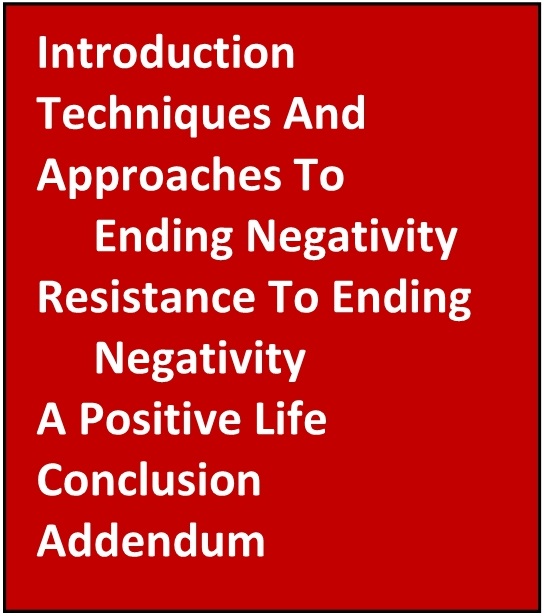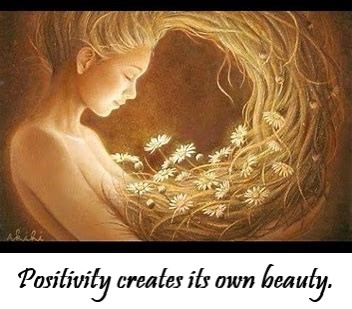Negativity: Techniques for Freeing Yourself (Part 2)
INTRODUCTION
In this Letter (Part 2), we continue the noble quest to free yourself from negativity by discussing additional techniques and approaches. Noble means important, lofty, and worthwhile. As mentioned in the December Letter, though the quest may take years, just the decision to begin the quest reaps immediate benefits as the excitement you can feel, feels good.
We use the Challenge for Your Growth as an excellent entry point for working with the issue of negativity. If you become familiar with the Challenge and understand how to use it, you can apply the Challenge to any issue you are dealing with. These are powerful ideas, straightforward and easy to understand, challenging to fully implement, and bringing out the best in us.
(The last Letter (December 2019) was Part 1. Reading the introduction to Part 1 is important. It is included here as an addendum. Also, you will see Roman numerals in the text that point to endnotes which refer to previous Letters that contain theory and practice relevant to the current topic.)
TECHNIQUES AND APPROACHES TO ENDING NEGATIVITY
Here are techniques and approaches for dealing with negativity. Some techniques are straightforward. Some approaches are complicated requiring understanding and practice to implement.
- Set and Accomplish Goals. Set goals and the objectives that are to be reached alone the way toward accomplishing the goal. Take the actions necessary to accomplish the goals. Here is an example of a goal and an objective. Over the next three months I will reduce my negativity by 30% by using one reduce negativity technique a day. You may use the same technique for a few days, then switch to a different technique or just stay with one technique. At the beginning of each day, write down the technique that you will use. Don’t worry about the percentage, it is just an estimate and an impression not an exact figure. Keep a written record or diary of your activity and progress or lack of progress.
- Analyze a Negative Belief. Examine a negative belief that frequently plagues you with a full analysis of its past origins, current effects on you now, and implications for the future if you continue to hold onto this belief. State the affirmation, “I now release this negative belief” after you have completed your analysis. Identify a positive belief that can substitute for it and put that belief into action. For example: “Nothing goes right for me.” This thought first came to me when I was 8 years old when I could not seem to make any friends. Whenever anything went wrong this is what I thought. It became a belief. In my life now, this belief discourages me, keeps me from trying new things, and causes some depression. If I continue to hold this belief I will continue to suffer its negative consequences and my depression might get worse. I now release this belief and substitute: “Sometimes things go well and sometimes things go poorly. When they go well I am happy. When they go poorly I seek to understand why and make the changes necessary to have more success in this situation.”
- Identify and Change Vicious Circles. Notice that you may be stuck in negativity with a vicious circle that perpetuates itself and reinforces the negativity. The vicious circle, a repeating self-fulfilling prophesy, starts with a negative belief and moves into a painful
 experience that reinforces the negative belief. Notice that this experience constantly repeats itself. Identify and change the negative belief that gives rise to the experience. With the belief, “Nothing ever goes right for me,” I might sabotage the possibility of making a new friend by walking around with a chip on my shoulder. When the friendship does not develop I say to myself, “You see, nothing ever goes right for me,” just like I did as a child/adolescent. I then develop a bigger chip on my shoulder and destroy more potential friendships.
experience that reinforces the negative belief. Notice that this experience constantly repeats itself. Identify and change the negative belief that gives rise to the experience. With the belief, “Nothing ever goes right for me,” I might sabotage the possibility of making a new friend by walking around with a chip on my shoulder. When the friendship does not develop I say to myself, “You see, nothing ever goes right for me,” just like I did as a child/adolescent. I then develop a bigger chip on my shoulder and destroy more potential friendships. - Experience More Pleasure. Bring more positivity into your life by experiencing more pleasure. There are an almost infinite number of sources of pleasure. For example, an easily available source of pleasure is your body. It provides sensual and sexual pleasure. Enjoy what your five senses bring you. Enjoy your sexuality. It is important to identify and change the beliefs that discourage you from having more pleasure in your life. For example, everyone has some degree of belief that pleasure is sinful, a waste of time, or just wrong. Our beliefs create a comfort zone. Expand your comfort zone for pleasure.
- Use the Challenge for Your Growth. The Challenge for Your Growth is: Think about every thought you have. Seek to feel good all the time. Give and receive only love. Think about every thought suggests being aware of your thinking and being prepared to examine negative thoughts. By seeking to feel good all the time, you can feel better than you do now. Let wanting to feel good be a motivation to start the process of ending negativity. Give and receive only love—truly a challenge. (The June 2019 Letter explains more about the Challenge and gives a detailed example of how to apply it. See endnote.[i] The Operating Manual for the Self has an entire chapter on the Challenge. Manualfortheself.com)
We said that negativity is caused by excessively negative beliefs, attitudes, thoughts, feelings, and expectations. The process of freeing yourself from negativity is a process of change that starts with identifying the beliefs that cause the attitudes, thoughts, feelings, and expectations they generate.[ii]
Let’s create a chart to help us organize ideas and generate questions and suggestions.
Challenge For Your Growth
| Components Of Negativity | Think About Thoughts | Seek to Feel Good | Give and Receive Only Love |
| Negative Beliefs | 1 | 2 | 3 |
| Negative Attitudes | 4 | 5 | 6 |
| Negative Thoughts | 7 | 8 | 9 |
| Negative Feelings | 10 | 11 | 12 |
| Negative Expectations | 13 | 14 | 15 |
Here are some examples of questions and suggestions that come from each box of the chart.
- If you have a negative belief, what would a loving belief be? Find and install the loving belief. (Box 3. Negative Beliefs and Give and Receive Only Love)
- If you have a negative feeling, what would a positive feeling look like? Find a way to create and feel the positive feeling. (Box 11. Negative Feelings and Seek to Feel Good)
- If you have a loving feeling that disappears too quickly, what negative belief do you need to identify, think about, and change? (Box 1. Think about Beliefs. And Box 3. Negative Beliefs and Give and Receive Only Love.)
- If you have an expectation that does not feel good, examine and evaluate the expectation. (Box 14. Negative Expectations and Seek to Feel Good)
- What beliefs do you have about love? Examine, evaluate, and if necessary change these beliefs. (Box 1. Think about Beliefs. And Box 3. Negative Beliefs and Give and Receive Only Love)
- When you feel badly about a loving relationship you have, explore the cause of this feeling. Resolve the cause. (Box 12. Seek to Feel Good, Give and Receive Only Love)
- Heal Trauma. Trauma is related to negativity in the following ways.

- Trauma causes us to believe that the world is a dangerous place and that we must continually be on guard to be safe. “No” is the necessary word we use to set boundaries and reject things that are not good for us. However, trauma causes us to say “no” excessively and unnecessarily, which is one of the definitions of negativity. (Paradoxically, there are times when trauma leads us to say “yes” when we should say “no.”)
- Trauma can generate an excessively negative and therefore a distorted, belief system.
- Trauma wounds us causing the hurt and pain that colors our experience of the world.
- Trauma causes us to lose parts of ourselves.
Practice: Seek an appropriate balance between “No” and “Yes.” Correct distorted beliefs. Heal wounds. Recover lost parts.
Practice: Go on a healing quest which includes psychotherapy, attending workshops and groups, being in nature, enjoying art and music, exercising, laughing and having fun, seeking to love and be loved, developing healthy religion and/or spirituality, and doing these activities with the intention and awareness that you are healing your trauma.
- Master Your Fear. As a feeling, fear often contains an important message for us, but it can also stop us from living fully. We can’t have fear and happiness, joy, and fulfillment at the same time. Along with the feeling of fear is a fearful thought and probably a negative belief. Identify and change the negative belief. (From the Challenge: Think about thoughts/beliefs and seek to feel good.)
- Change Your Self-image. We have many images about ourselves. We have the saying, “A picture is worth a thousand words.” A self-image is a picture containing many ideas about some aspect of ourselves. If you experience a lot of negativity you probably have a self-image of being a negative person. Begin to change this image by stating the affirmation, “I am no longer a negative person. I am a person who sees the positive and negative in life. My belief about life is that life is essentially good.” State the affirmation when you detect you negativity at work. Image work like this can be particularly powerful in that it addresses important aspects of ourselves in a global manner. An analogy, if you change the house (image) you live in, every room inside (aspects of yourself) is changed. Changing a self-image makes every belief, attitude, thought, feeling, and expectation different. (Fully explore images and changing images in chapter 17 “Image” in The Operating Manual for the Self. manualfortheself.com)
RESISTANCE TO ENDING NEGATIVITY
Resistance is something, usually a belief, that prevents change from happening, or slows it down once it has started. When we seek to change anything about ourselves there are two forces, motivation and resistance. Motivation moves us forward and resistance holds us back. Both contain beliefs that we act upon. Since ending negativity involves change, it is natural that there would be some resistance. The resistance that holds us back usually takes the form of “the reason I should not change.” Some examples are:
- Negativity protects me and keeps me safe from the dangers of the world.
- Negativity keeps me from getting disappointed by keeping my expectations low.
- Negativity is a family tradition. If I let it go I won’t be part of this family anymore.
- Changing my negativity takes too much time and effort.
- Negativity is an important part of my self-image. If I let it go I won’t know who I am.
- My friends and I bond by complaining. I might lose them if I let go of my negativity and stop complaining.
- What will I do with my time if I let go of my negativity? I might try something new and fail.
Practice: Identify and change the beliefs that generate your resistance.
A POSITIVE LIFE
(These ideas from the December 2019 Letter are so important that we repeat them here.)
Creating a positive experience of life is partly about what you consistently focus your attention on. Focus on the positive/pleasurable aspects that exist in any moment of time. Experience the good feelings that follow. This will change your mood. Focus on:
- The light and warmth of the sun
- The intricate texture of the clouds
- The beauty that completely surrounds us
- Children at play
- People feeling happy and enjoying themselves
- The taste of a good meal
- The heroic struggle of human beings
- Wonder, goodness, and love
- The Divine
Expand this list by adding the things that make you feel good. The number of possibilities is almost endless. We are not saying that one should deny the “negative” as the negative is part of life. But whenever possible, after noticing the negative focus on a positive aspect of what you have noticed.
Point Of Empowerment: Remember, we are totally in control of what we focus our attention on.
CONCLUSION
As we come to the end of this exploration we can see that ending negativity is part of our life’s journey and can take many years. As part of our life’s journey, we can see that ending negativity can make a big difference in the amount of happiness, joy, and fulfillment that we experience in our life.
ADDENDEM
Here is the introduction to the December 2019 Letter.
INTRODUCTION
Freeing yourself from negativity: freeing is an accurate word in that we can feel caught and powerless in the grip of negativity. However, as we understand how we create our negativity we can feel empowered to eliminate it. Freeing yourself from negativity is a quest, a process, a “work in progress.” Something that takes a while but generates benefits along the way.
How do you know that you have too much negativity? You can consult the list of effects of negativity contained in the October 2019 Letter.[iii] If you are experiencing many of the affects you have too much negativity. We said that negativity is an overly negative approach towards life and is caused by excessively negative beliefs, attitudes, thoughts, feelings, and expectations. The process of freeing yourself from negativity is a process of change that starts with identifying the beliefs that cause the attitudes, thoughts, feelings, and expectations that generate negativity. Getting stuck in negativity is a vicious circle that perpetuates itself and reinforces negativity. A negative belief gives rise to a painful experience that reinforces the negative belief. (“You see I told you so. I knew that I was right to think this way.”)
(We are talking about the importance of your beliefs. You can find a full exploration of beliefs in the March to July 2018 Letters, see index[iv]. The May 2018 Letter[v] describes how to discover what your beliefs are. The June 2018 Letter[vi] explains how to generate new beliefs and how to change beliefs.)
There is no quick fix to ending negativity but the sustained effort to eliminate negativity generates immediate rewards in reducing the amount of destructiveness in your life. Also, you immediately open yourself to more positive experiences. Since there is no quick fix, some of the approaches to ending negativity can be complicated. But working with them is life changing, changing in “small, medium, and large” ways.
Practice: Tune into your pleasure and pain as clues to the positive and negative in your life. Consider the question, “Am I experiencing too much pain and therefore too much negativity?” Begin the quest to end negativity.
[i] Challenge For Your Growth. June 2019. https://iifsd.org/library/newsletters/june-2019-letter/
[ii] There is a complete guide to understanding, identifying and changing beliefs available in the Letters of March, April, May, June, and July of 2018. The May and June letter focus specifically on identifying and changing beliefs. Letter Index. https://iifsd.org/library/newsletters/
[iii] October 2019 Effects of Negativity. https://iifsd.org/library/newsletters/october-2019-letter/
[iv] Letter Index https://iifsd.org/library/newsletters/
[v] May 2018 Identify Beliefs https://iifsd.org/library/newsletters/may-2018-letter/
[vi] June 2018 Changing Beliefs https://iifsd.org/library/newsletters/june-2018-letter/
